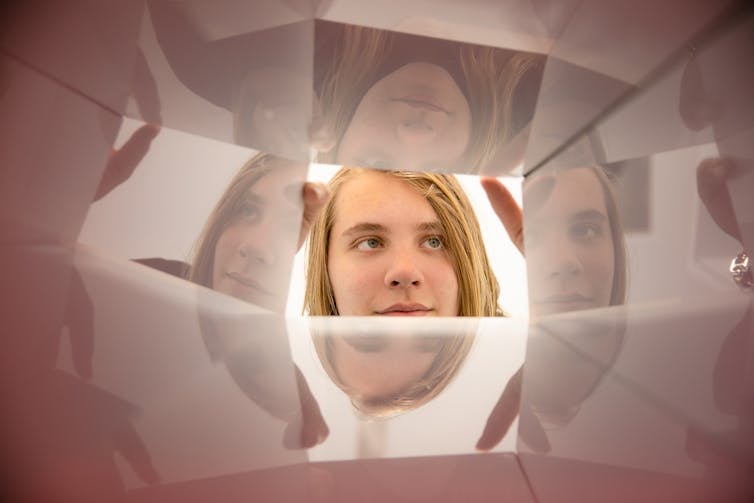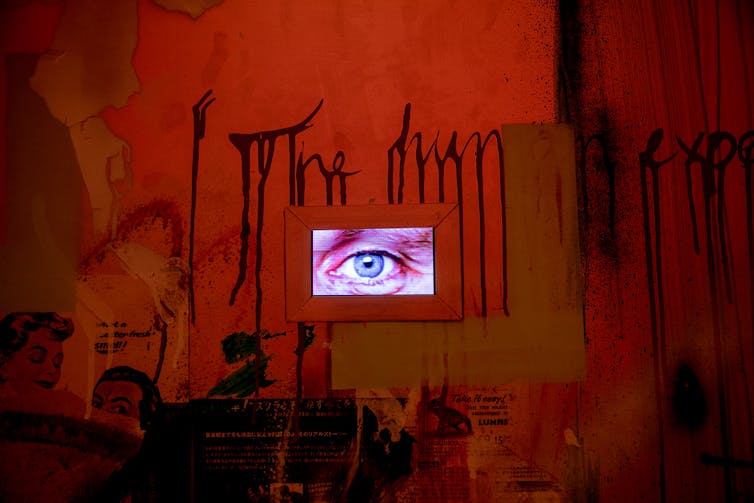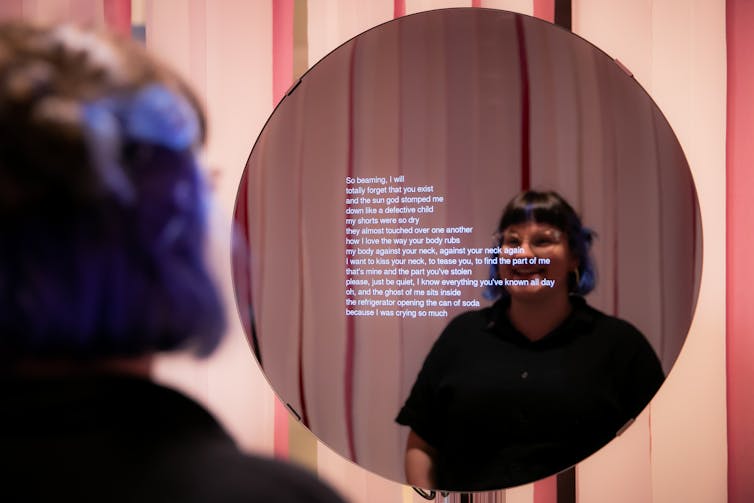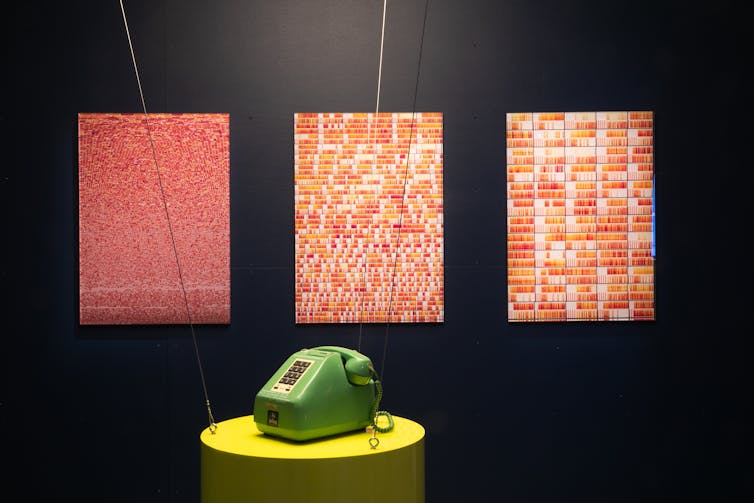Source: The Conversation (Au and NZ) – By Nick Haslam, Professor of Psychology, The University of Melbourne

Review: MENTAL: Head Inside, curated by Tilly Boleyn.
After three false starts due to lockdown, the Science Gallery’s inaugural exhibition, MENTAL: Head Inside, is opening at its new space in Carlton.
The gallery is one node in a global network of youth-focused spaces that playfully kicks down the walls between art and science.
Previous Science Gallery exhibitions — BLOOD, PERFECTION and DISPOSABLE — were held in different temporary locations. Curated by and for young people, MENTAL is both a homecoming and a housewarming in an airy, purpose-built space.
Confronting and comforting
Two years in the making, MENTAL was curated in defiance of the pandemic by a team of professional curators, an advisory group of young people and experts. The works on display are the fruits of an international open call on the expansive topic of the human mind. They invite engagement and interaction rather than chin-in-hand appraisal.
Although the exhibition explores the mind’s many dimensions, it tilts toward timely issues of mental health.

Science Gallery/Alan Weedon
The most confronting is Rory Randall and Indigo Daya’s Isolation Chamber, a recreation of a seclusion room for involuntarily detained psychiatric patients. The practice is due for elimination following the Royal Commission into Victoria’s mental health system.
Visitors can enter and experience the pinned helplessness of being surveilled from many angles by those outside. Like many other exhibits, visitors can also record their reactions.
Emily Fitzsimons’ Cushions, knitted in the form of assorted pills, reflect on the role of medication in mental health treatment.
Relief of another sort is offered by Wemba Wemba and Gunditjmara artist Rosie Kalina’s Respite Space, a sanctuary where the mental health of First Nations people is front and centre.
Read more:
The rise of pop-psychology: can it make your life better, or is it all snake-oil?
Fear and influence
Selfcare4eva has Mary Angley and Caithlin O’Loghlen inhabit an in-gallery bedroom in their quest to become famous wellness influencers. A frenzy of wellness-related video and image content creation is promised, to which visitors can add when the artists surrender the room to the public.
The richness of human emotion presented extends beyond wellness, of course. Zhou Xiaohu’s mesmerising Even in Fear has a weather balloon inflate menacingly within a pink, vaguely ribcage-like enclosure. Some may find the suspense frightening, others thrilling.
Fear and nightmares also animate some of Indigenous artist Josh Muir’s sumptuous visual designs and soundscapes in Go Mental. The dreamlike feel of his work leads into the visual and auditory distortions and trippiness of Nwando Ebizie’s Distorted Constellations. Like several of the exhibits, hers is partnered with an ongoing research project.

Science Gallery/Alan Weedon
Gut feelings
Music is also central to Sophia Charuhas’ Microbial Mood. A live experiment tests whether different kinds of music differently influence the growth of gut bacteria, collected in petri dishes above a set of speakers. The artist speculates future music could be used to enhance health by fine-tuning the gut-brain connection.
Emanuel Gollob’s beautiful sea-sponge-like robot in Doing Nothing with AI is also responsive, moving slowly and sinuously to relax the viewer. A headset transmits the brainwaves of observers as they admire the strange seaborg.
Nina Rajcic’s remarkable Mirror Ritual generates a personalised poem based on the visitor’s facial expressions, read as they front a mirror.

Science Gallery/Alan Weedon
Read more:
Personalities that thrive in isolation and what we can all learn from time alone
Meeting of minds
Mental life happens inside our heads, but several exhibits recognise the importance of interactions between minds. Hiromi Tango and Emma Burrows’ Wheel invites visitors to try out a rainbow-striped hamster wheel, exploring how social rewards promote exercise.
Georgie Pinn’s Echo uncannily dramatises the experience of empathy. The visitor listens to another person’s story while looking at their face. Gradually their own face appears to take over the narrator’s.
The opposite phenomenon is presented in Your Face is Muted, by computer scientists Tilman Dingler, Zhanna Sarsenbayeva, Eylül Ertay, Hao Huang and Melanie Huang. The difficulty of maintaining online video conversations when faces become hard to read is illustrated dramatically in this interactive exhibit. Anyone who has experienced a patchy video conversation will relate.

Science Gallery/Alan Weedon
Rachel Hanlon’s charming Hello Machine, Hello Human allows visitors to initiate a spontaneous phone call with another person … or does it? Hanlon’s work is an artistic rendition of Alan Turing’s famous test of whether a machine can pass as human.
Colour and movement
Overall, the exhibition has a sense of lightness and dynamism. There are gobs of colour everywhere, darker nooks to explore, and high ceilings and abundant natural light.
At a time when the importance of STEM education is almost universally acknowledged, if not adequately funded, STEM needs to show itself as welcoming, open and attractive. If we want young people to engage with science and technology, they must be able to see these fields not as obscure bodies of knowledge and mechanical methods but as pathways to creative discovery.
By showcasing the works of diverse young artists and scientists who collaborate to explore the issues of the day, MENTAL delivers a powerful message on the value and creative possibilities of science. It is an exemplary exhibition that deserves a visit, whether you are 15, 25 or 85.
MENTAL: Head Inside runs until June 18 at Science Gallery Melbourne.
![]()
Nick Haslam works for the University of Melbourne, with which Science Gallery Melbourne is affiliated, and has in the past consulted on an unpaid basis with the gallery.
– ref. From fear to connection, dynamic MENTAL exhibition explores a colourful spectrum of experiences – https://theconversation.com/from-fear-to-connection-dynamic-mental-exhibition-explores-a-colourful-spectrum-of-experiences-164358







